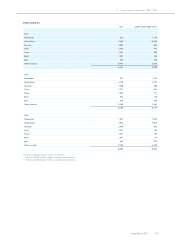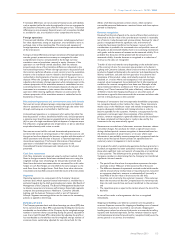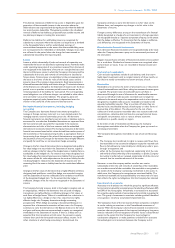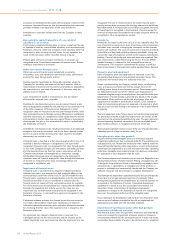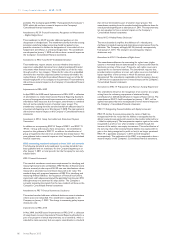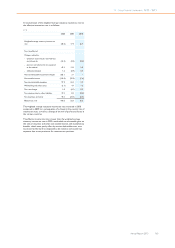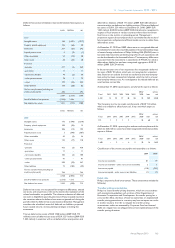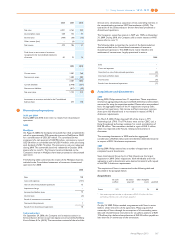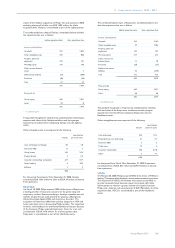Philips 2010 Annual Report Download - page 159
Download and view the complete annual report
Please find page 159 of the 2010 Philips annual report below. You can navigate through the pages in the report by either clicking on the pages listed below, or by using the keyword search tool below to find specific information within the annual report.
13 Group financial statements 13.10 - 13.10
Annual Report 2010 159
and measured by a comparison of the carrying amount of an asset with
the greater of its value in use and its fair value less cost to sell. Value in
use is measured as the present value of future cash flows expected to be
generated by the asset. If the carrying amount of an asset is deemed not
recoverable, an impairment charge is recognized in the amount by
which the carrying amount of the asset exceeds the recoverable
amount. The review for impairment is carried out at the level where
discrete cash flows occur that are independent of other cash flows.
Impairment losses recognized in prior periods are assessed at each
reporting date for any indications that the loss has decreased or no
longer exists. An impairment loss is reversed if and to the extent there
has been a change in the estimates used to determine the recoverable
amount. The loss is reversed only to the extent that the asset’s carrying
amount does not exceed the carrying amount that would have been
determined, net of depreciation or amortization, if no impairment loss
had been recognized. Reversals of impairment are recognized in the
Statements of income.
Goodwill
Measurement of goodwill at initial recognition is described under ‘Basis
of consolidation’. Goodwill is subsequently measured at cost less
accumulated impairment losses. In respect of investment in associates,
the carrying amount of goodwill is included in the carrying amount of
investment, and an impairment loss on such investment is not allocated
to any asset, including goodwill, that forms part of the carrying amount
of investment in associates.
Impairment of goodwill
Goodwill is not amortized but tested for impairment annually and
whenever impairment indicators require. In most cases the Company
identified its cash generating units as one level below that of an
operating segment. Cash flows at this level are substantially
independent from other cash flows and this is the lowest level at which
goodwill is monitored by the Board of Management. The Company
performed and completed annual impairment tests in the same quarter
of all years presented in the Consolidated Statements of income. A
goodwill impairment loss is recognized in the Statement of income
whenever and to the extent that the carrying amount of a cash-
generating unit exceeds the recoverable amount of that unit. An
impairment loss on an investment in associates is not allocated to any
asset, including goodwill, that forms part of the carrying amount of the
investment in associates.
Share capital
Common shares are classified as equity. Incremental costs directly
attributable to the issuance of shares are recognized as a deduction
from equity. Where the Company purchases the Company’s equity
share capital (treasury shares), the consideration paid, including any
directly attributable incremental costs (net of income taxes) is
deducted from equity attributable to the company’s equity holders until
the shares are cancelled or reissued. Where such ordinary shares are
subsequently reissued, any consideration received, net of any directly
attributable incremental transaction costs and the related income tax
effects, is included in equity attributable to the company’s equity
holders.
Debt and other liabilities
Debt and liabilities other than provisions are stated at amortized cost.
However, loans that are hedged under a fair value hedge are
remeasured for the changes in the fair value that are attributable to the
risk that is being hedged.
Provisions
Provisions are recognized if, as a result of a past event, the Company has
a present legal or constructive obligation that can be estimated reliably,
and it is probable that an outflow of economic benefits will be required
to settle the obligation. Provisions are measured at the present value of
the expenditures expected to be required to settle the obligation using
a pre-tax discount rate that reflects current market assessments of the
time value of money and the risks specific to the obligation. The
increase in the provision due to passage of time is recognized as interest
expense.
A provision for warranties is recognized when the underlying products
or services are sold. The provision is based on historical warranty data
and a weighing of possible outcomes against their associated
probabilities.
The Company accrues for losses associated with environmental
obligations when such losses are probable and can be estimated reliably.
Measurement of liabilities is based on current legal and constructive
requirements. Liabilities and expected insurance recoveries, if any, are
recorded separately. The carrying amount of liabilities is regularly
reviewed and adjusted for new facts and changes in law.
The provision for restructuring relates to the estimated costs of
initiated reorganizations that have been approved by the Board of
Management, and which involve the realignment of certain parts of the
industrial and commercial organization. When such reorganizations
require discontinuance and/or closure of lines of activities, the
anticipated costs of closure or discontinuance are included in
restructuring provisions. A liability is recognized for those costs only
when the Company has a detailed formal plan for the restructuring and
has raised a valid expectation with those affected that it will carry out
the restructuring by starting to implement that plan or announcing its
main features to those affected by it.
Guarantees
The Company recognizes a liability at the fair value of the obligation at
the inception of a financial guarantee contract. The guarantee is
subsequently measured at the higher of the best estimate of the
obligation or the amount initially recognized.
Accounting changes
In the absence of explicit transition requirements for new accounting
pronouncements, the Company accounts for any change in accounting
principle retrospectively.
Reclassifications
Certain items previously reported under specific financial statement
captions have been reclassified to conform to the current year
presentation.
IFRS accounting standards adopted as from 2010
The accounting policies set out above have been applied consistently to
all periods presented in these Consolidated financial statements except
as explained below which addresses changes in accounting policies.
The Company has adopted the following new and amended IFRSs as of
January 1, 2010.
Revision to IAS 27 ‘Consolidated and Separate Financial Statements’
The revised standard requires the effects of all transactions with non-
controlling interests to be recorded in equity if there is no change in
control and these transactions will no longer result in goodwill or gains
and losses. The standard also specifies the accounting when control is
lost. Any remaining interest in the entity is remeasured to fair value, and
a gain or loss is recognized in profit or loss. The Company applied IAS
27 (revised) prospectively to transactions with non-controlling
interests as from January 1, 2010.
Revision to IFRS 3, ‘Business Combinations’
The revised standard continues to apply the acquisition method to
business combinations, with some significant changes. For example, all
payments to purchase a business are to be recorded at fair value at the
acquisition date, with contingent payments classified as debt
subsequently re-measured through the Statements of income. The
definition of a business has been broadened, which likely results in more
acquisitions being treated as business combinations. There is a choice
on an acquisition-by-acquisition basis to measure the non-controlling
interest in the acquiree at fair value or at the non-controlling interest’s
proportionate share of the acquiree’s net assets. All acquisition-related
costs other than share and debt issuance costs, should be expensed.
The Company applied IFRS 3 (revised) prospectively to all business
combinations as from January 1, 2010.
IFRIC 17, ‘Distribution of Non-cash Assets to Owners’
The interpretation is part of the IASB’s annual improvements project
published in April 2009. This interpretation provides guidance on
accounting for arrangements whereby an entity distributes non-cash
assets to shareholders either as a distribution of reserves or as
dividends. IFRS 5 has also been amended to require that assets are
classified as held for distribution only when they are available for
distribution in their present condition and the distribution is highly






